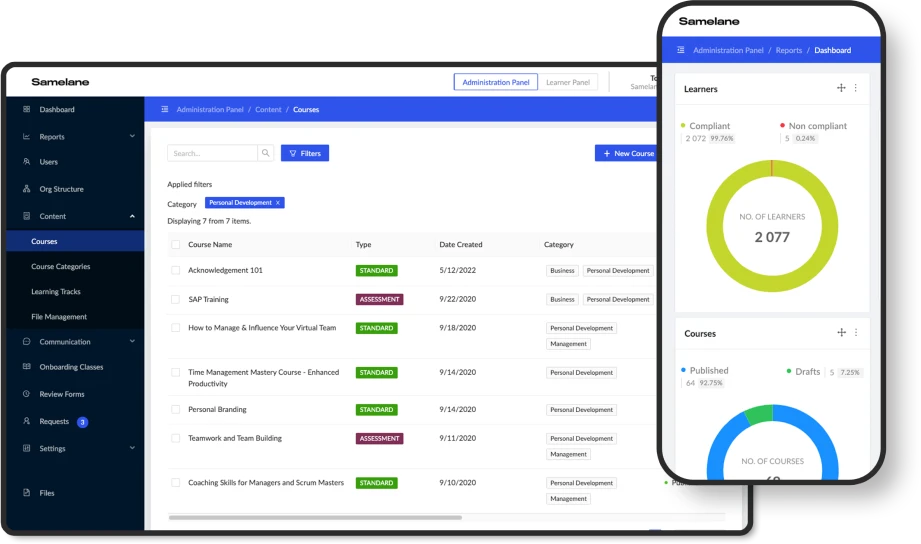Effective talent management in an organization can only be achieved through a strategy which utilizes the knowledge of how to educate adults, boost their motivation, and take advantage of their talents.
This article will explain the following:
- how to teach adults and what their learning styles are;
- what is Kolb’s learning cycle (which will introduce the way of acquiring knowledge by adult learners);
- how to motivate adult learners and use e-learning to do so.
Adult education
Nowadays, the continuous acquisition of new information and skills is a necessity. The constantly changing environment requires it. Even the performance of the simplest tasks, such as communicating with employees, has changed over the past decades and is today aided by technology. This state of affairs is natural for generation Z, who is said to be born with a phone in her hand and supposedly does not know the world without technology. On the other hand, previous generations still have to adapt to the surrounding reality – both in the private and professional environment. There is no other way to achieve this goal than through education. However, due to differences in approach, needs and motivation, adult learning is not and cannot be a copy of school-time behavior.
How to teach adults?
Recent research shows that with constant intellectual activity, the ability to learn in adults can still be developed and only slightly decreases compared to children or teenagers. With the right choice of teaching methods, people who have already completed school education will eagerly and effectively learn using what is called crystallized intelligence. This means that they will take advantage of their previous experiences, mental habits, thinking strategies, and knowledge organization. Therefore, when preparing an adult education plan, it is necessary to take into account, among other things, the preferences and abilities of the participants. The fact that they have a completely different approach to learning than children was confirmed by M. S. Knowles, who also proposed that in order to effectively assimilate knowledge, adult learners
- need to know the purpose of education – why they want to learn;
- prefer empirical education and, through it, achieve better results;
- approach learning similarly to problem solving;
- learn best when the subject is of direct value to them.
Additionally, adult education is more effective if learners’ needs are taken into account. The 4 learning styles described below can be helpful in determining the optimal approach.
Active style (empiricist) – preferred by people who acquire knowledge most efficiently through action and experience. The best form of learning is a practical training course based on the experience of the instructors.
Reflective style (contemplatist) – displayed by people who like to observe the actions of others and evaluate the effects, with particular emphasis on cause-effect relationships. They value participation in case studies or material analysis.
Theoretical style (theorist) – as the name suggests, it is characteristic of people who prefer to learn from existing theoretical models. This is often associated with an analytical and conceptual approach to learning. They are eager to assimilate the knowledge of instructors or experts.
Pragmatic style (pragmatist) – such people frequently focus on solving practical problems and performing tasks. Being able to apply acquired knowledge immediately is fundamental to their way of learning.
David Kolb’s method is also worth mentioning here. Its model has already entered the canon of training course creation. This concept has a solid scientific basis and makes references to, among others, the theories of John Dewey, Kurt Lewin and Jean Piaget.
Kolb distinguished the four following stages of learning:
Concrete Experience – allows learners to interact, for example with the client or end user of the services provided.
Reflective Observation of the New Experience – when the experienced situation is thoroughly analyzed and criticized from many perspectives.
Abstract Conceptualization – when conclusions are drawn and regularities are discovered.
Active Experimentation – when competences are verified in practice.

What motivates adults to learn
In addition to analyzing learning styles, goals and process values, one should not forget about boosting motivation. M. Knowles comes to the rescue again. He defined four main factors influencing the involvement of adult learners. They are as follows:
Success – adults want to learn successfully.
Will – adults must have a sense of influencing their education.
Value – adults need to be convinced that they are learning something worthwhile.
Pleasure – adults expect learning to be a source of satisfaction for them.
Consequently, it is crucial to use proper techniques to fulfill the above-mentioned requirements.
Methods and tools to improve involvement with the use of e-learning
Choice awareness and voluntary learning are often insufficient for achieving educational success. Therefore, these aspects should be upheld and thus contribute to success, value, and pleasure in learning. E-learning platforms can be of great help, because they use the best teaching methods and allow companies to directly influence the results. The following tools directly influence student involvement:
Influence
LMS platforms allow participants to choose courses. Interesting content can be selected instead of just the content assigned by the management. This choice supports the selected career path and boosts motivation – or will – but it can also affect the pleasure of learning.
Challenges
One of the factors improving involvement is testing. Tests and exams motivate students to acquire knowledge, and, above all, they allow participants to be successful. Some people are additionally motivated by the possibility of competing with others.
Monitoring progress
One training course is seldom enough to raise the selected competence. Employees can stay motivated by seeing the progress they are making, especially when dealing with complex issues. In such a situation, reports showing progress stages in a given cycle and giving access to obtained achievements can be extremely important.
Awards and certificates
Some Learning Management Systems offer certificates and badges for completing courses or passing tests, which directly translates into the value of the training course. The chance to display such proof of success on internal company channels or on social media is a source of satisfaction.
Proper course designing techniques
There are essential aspects which should not be neglected when designing courses, for example limiting the content to the necessary amount, ensuring pleasing aesthetics of the course, user comfort (appropriate colors, typeface, transparency, and simplicity), and attractiveness (interactive elements and animations). This affects the efficiency and pleasure of a given process.
Incentive diversification
Using engaging forms when designing courses is worthwhile. Training documentation is extremely useful, but it provides better results when it is reinforced with audio, video, quizzes and interactive elements. Due to such improvements, training courses will be more pleasant.
Teaching adults can and should be adapted to their needs and predispositions. Adult learners need to be aware of the purpose and value of learning and the learning path itself should also be designed not only to utilize previous trainee experience, but also to provide success opportunities, transparent educational value and general enjoyment. This approach allows companies to achieve great results, especially when developing and managing talent in the organization, and one of the means to achieve this goal is an LMS platform.










